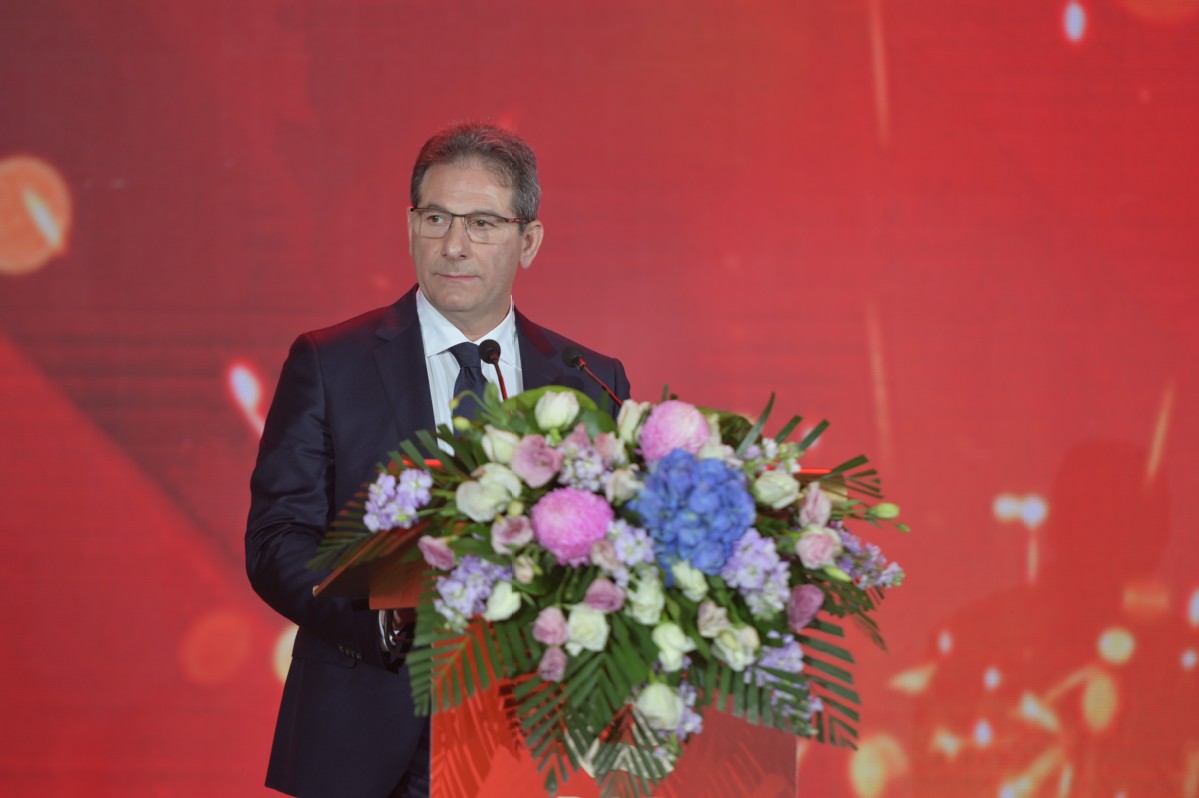China's financial liberalization can unlock new opportunities


Editor's note: Despite global uncertainties and the economic downturn caused by the COVID-19 outbreak, China is on track to embrace the dual-circulation development pattern as it enters the 14th Five-Year Plan period (2021-25) in 2021, which also marks the 100th anniversary of the founding of the Communist Party of China.
China Daily website asked senior executives of multinational companies to share their views on the country's economic development and their companies' business strategies in China.
In this episode, China Daily website talks with Intesa Sanpaolo, the largest Italian bank, which is also an opening-up beneficiary and contributor of Chinese financial market.
Q1. How do you see the role of the Chinese market in your global layout?
Our intention is to make China our second biggest market, led only by our home market of Italy. Today, Intesa Sanpaolo is the largest Italian bank and the Eurozone's No 3 bank by market capitalization. We are a multinational group with one-third of our customers located outside Italy, served by 12 banks Intesa Sanpaolo owns worldwide. And we continue to grow as a group, most recently through our acquisition last year of UBI Banca, Italy's No 4 bank. In recent years, we have focused our business model on wealth management and protection, leveraging decades of expertise and the financial strength of our clients. Today, we manage over EUR 1.1 trillion in customer financial assets. And our business model has made us a European leader in profitability, efficiency and capital strength.
Our commitment to China is deep and we have very ambitious plans for the future. In 1981, we inaugurated our Representative Office in Beijing. We then established a Representative Office in Shanghai in 1987, which later in 1997 became a branch . In 2007, we bought a 49 percent stake in Penghua, now China's No 10 asset manager. The following year, we acquired a 20 percent stake in Bank of Qingdao, the maximum share allowed at the time. Now, we are giving even more priority to our growth in China, with the ambition to build a 360-degree financial business for China's affluent, HNWI and corporate clients that provides banking services, wealth management and insurance. Last year, we received a license to distribute wealth management products and officially launched Yi Tsai. Now, we will request a license to distribute insurance products to enhance our wealth management offer. We will have many things to announce in the future.
For me, the excitement and ambitions regarding our prospects in China are also very personal. I have been a board member of Bank of Qingdao since 2012, and I normally travel to China three or four times per year. Until the end of 2019, I was Intesa Sanpaolo's Group Chief Operating Officer. Then in January – demonstrating the primary importance we are putting on our growth in China – our CEO asked me to focus on leading the new strategic China Project initiative.
Q2. The Chinese government has introduced a series of initiatives to optimize the business environment, including the Foreign Investment Law. What changes have you seen in China's business environment?
We are very impressed by China's continued work to open its financial sector, and we have seen a real acceleration of these efforts in recent years. When the central government authorized foreign banks to open Representative Offices back in 1981, we believe we were the first to receive such an authorization. In the years that followed, our group has carefully monitored the market's opening and we have responded whenever this presented new opportunities. That's why we invested in Penghua and Bank of Qingdao, two important holdings that we still retain and will continue to support in the future.
Last year, we directly benefitted from even greater openness when we obtained a Fund Distribution License for Yi Tsai, our wholly-owned subsidiary established in Qingdao in 2016. And, thanks to the new regulations, we are now applying for a securities license through a joint venture in which our group will hold the controlling majority. These are all concrete results of China's new business environment, as well as of our group's attention to new opportunities in China. It's worth noting that 2020 was an important year with significant regulatory changes in Chinese financial services. Within such a context, China is progressively favoring the development of capital markets similar to international standards.
Q3. After such a long presence in China, how would you describe ISP's relations with Chinese authorities?
With such a long history in China, Intesa Sanpaolo has had a great opportunity to build very sound, win-win relations with central and local authorities and regulators. These are relations based on mutual knowledge and understanding enabled by the successful dialogue that we have built.
This cooperation has also gained the attention and support of the governments of our two countries. This was evident at the signing of a Memorandum of Understanding between the Municipality of Qingdao and Intesa Sanpaolo in the presence of Chinese President Xi Jinping and Italian Prime Minister Giuseppe Conte in Rome in March 2019. We are in constant touch with the central authorities, and I believe Intesa Sanpaolo's projects in China represent a good example of successful cooperation between the two countries.
Q4. What are the biggest achievements China has made since the introduction of the reform and opening-up policy 40 years ago? What will you expect from the next 5-year plan?
The achievements are truly impressive. China is now the world's second-largest economy, and when GDP is measured in purchasing power parity terms, it is now No 1. China has increased foreign direct investments from $920 million at the end of 1983 to $135 billion in 2017, the last figure I remember. These numbers mark an incredible achievement also because they are the result of the reforms and the work done at all levels in past years.
China's economy is also demonstrating a maturity that leads us to believe it will be one of the world's leading economies for many years to come. We expect it to be an economy so interconnected with the rest of the world that China will increasingly become a center of excellence and know-how in many business fields. As Intesa Sanpaolo, we are eager to provide our contribution in creating the world's second global financial center.
Q5. How do you view the potential of the Chinese market?
China is already the second-largest wealth management market in the world. We believe firmly that China's blossoming domestic economy will play to Intesa Sanpaolo's strengths in wealth management and protection. In particular, we see Chinese clients moving from a product-based approach in wealth management to one that values personalized advisory services.
This is a significant shift because it moves the industry away from the risk of one-size-fits-all commoditization. Clients really benefit, because it pushes best-in-class wealth managers to focus on quality of service as well as results. As I mentioned, this really plays to Intesa Sanpaolo's decades of experience in wealth management. One of the drivers of our success has been our network of financial advisors, who are highly motivated to directly satisfy their clients through professional advisory. This is a model that has worked especially well in Italy and the US, two very entrepreneurial cultures.
Q6. What's your investment plan for the country? What kind of new initiatives will you introduce to continue driving business growth in the country?
As I mentioned, at the beginning of 2020 our CEO gave me responsibility to lead a new strategic China Project initiative. The aim is to maximize all our investments in China and create a platform able to cover all financial sectors.
We are planning significant investments across various financial fields, and we will evaluate all the market opportunities that emerge thanks to recent policies for greater openness. Looking specifically at our recently-launched Yi Tsai wealth management business, 2021 is the year in which the investments made can be translated into satisfied customers and increased assets under management. It is also the year in which we can begin our expansion outside of Qingdao and Shandong, aiming to be present in four or five major Chinese cities.
But our plans are even more ambitious, and I look forward to sharing the details when the time comes.
Q7. What's your impression of Chinese consumers, and what's your localized strategy in China?
China's wealth management market is young and vibrant, still experiencing exponential growth. Over the years, we have seen an evolution in Chinese client behavior that has shifted closer, in some respects, to that of Western clients. More and more clients are recognizing the importance of wealth preservation, giving weight to long-term products focused on security more than return on investment. The COVID experience has driven growing awareness of the need for wealth protection. Family wealth inheritance is also a significant topic, and a rather new concept in China.
Yi Tsai is determined to bring to China a successful service model that has been developed and proven for many years in Europe, focused on finding the right investment solution for clients based on analyzing individual needs and risk tolerance linked to specific life goals. Another mission of Yi Tsai is to bring good risk control systems and management concepts to the Chinese wealth management industry.
At the same time, we are seeing trends unique to China. One that stands out is the digitalization of the customer experience. As a financial institution with millions of customers and decades of experience, we are of course eager to bring our know-how and best practices to the Chinese market. But at the same time, we are adapting our service models to the advanced digitalization of the Chinese market. This has led to a unique solution that brings the competence and qualified service of Intesa Sanpaolo to customers through their smartphones, while protecting the fundamental relationship between our customers and us, which is the core of our service model.


































